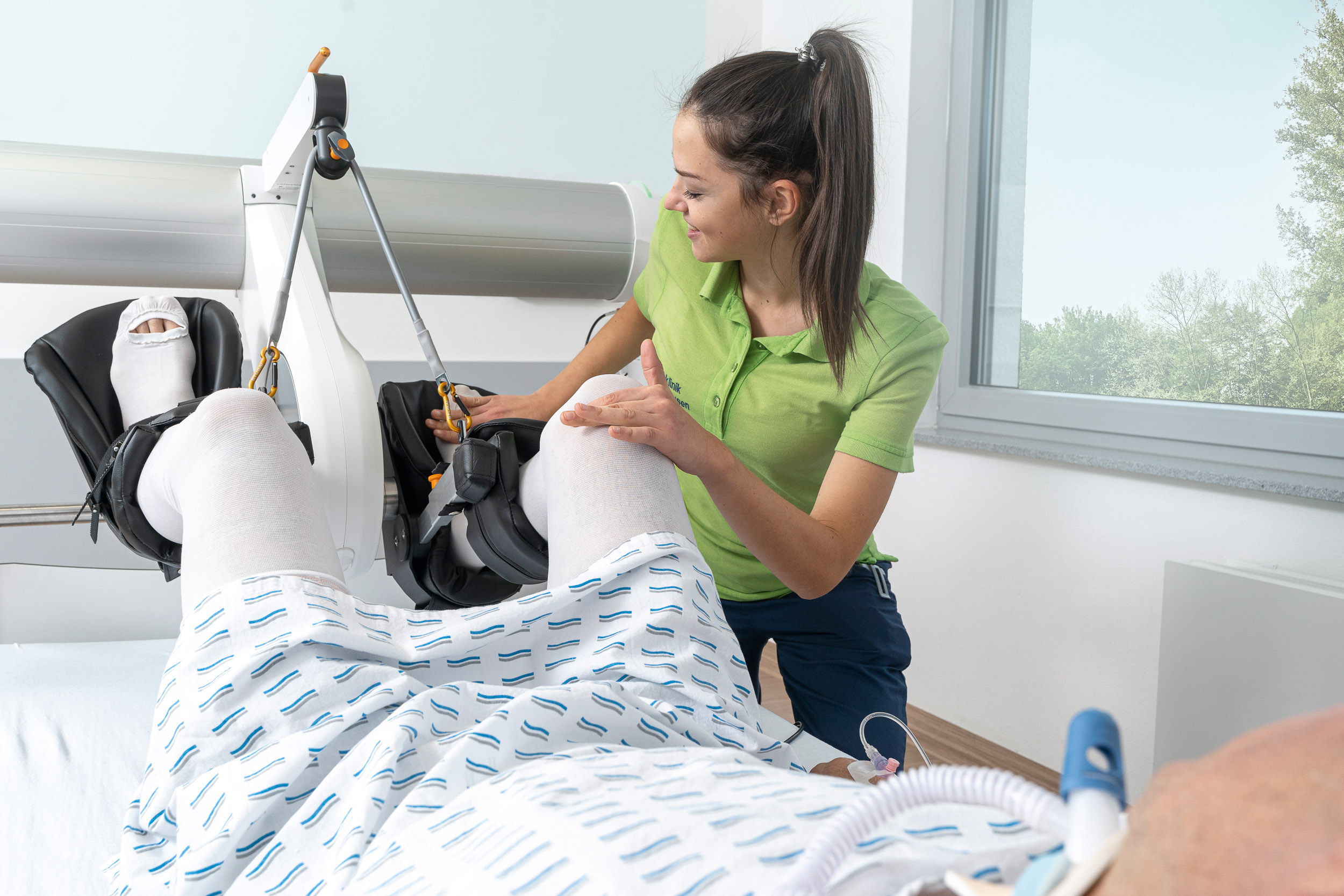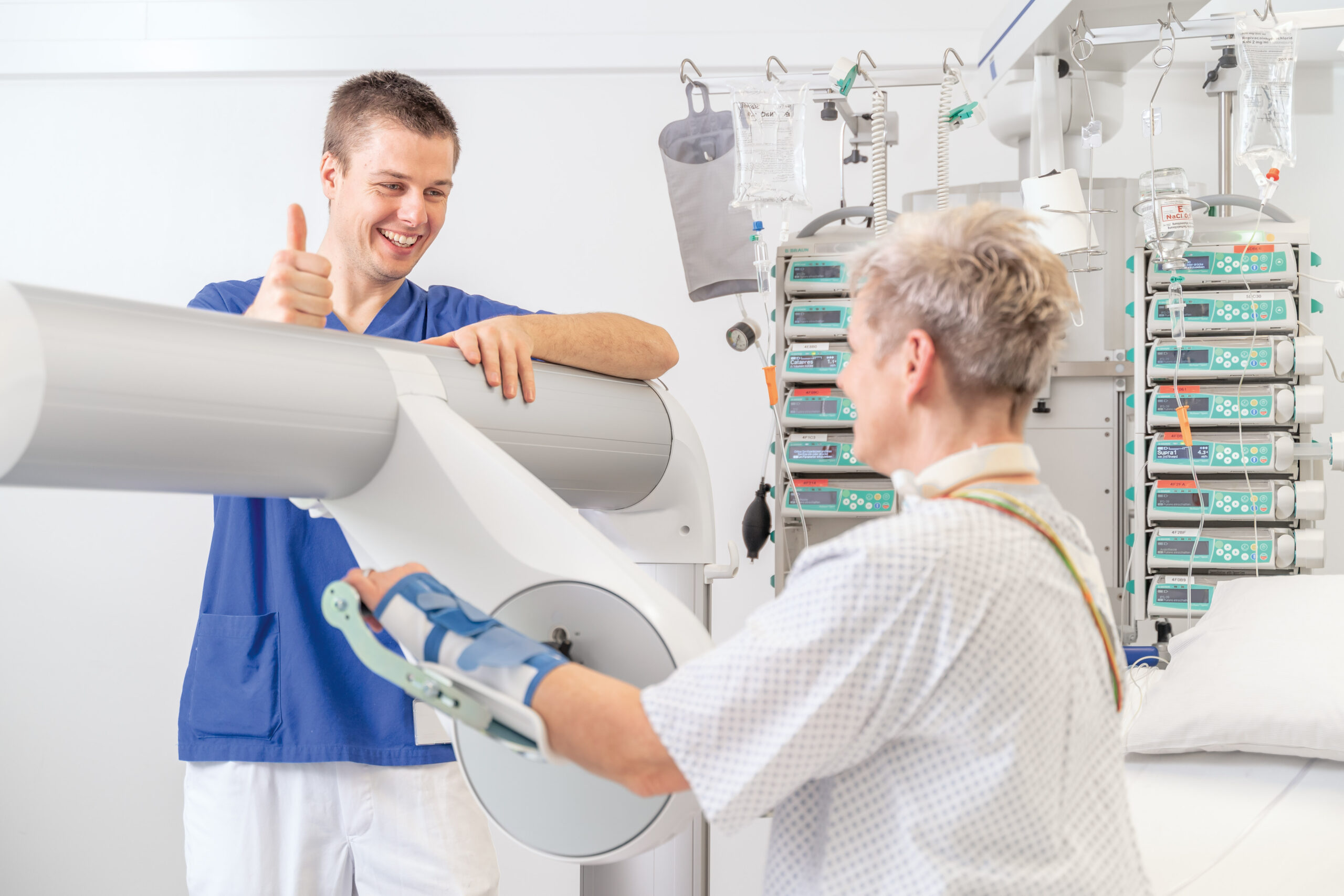
THERAPY Magazin
Cycling after an acute stroke
A clinical trial confirms that cycling with a movement trainer in the acute stroke phase improves walking speed, balance, and muscle power. Discover why early mobilisation matters.

Jakob Tiebel
Health Business Consultant
Comparison of cyclical movement training and conventional physiotherapy to improve muscle power, walking speed, balance and mobility in the acute phase after stroke: a randomized clinical trial
In a randomised clinical trial, 20 stroke patients in the acute phase after the event were divided into a control group (CG) and an intervention group (IG). In addition to conventional physiotherapy, the IG carried out daily sessions with a movement exerciser. The results showed significant improvements in muscle power, walking speed and balance in the IG. These findings underline the effectiveness of the movement exerciser in early mobilisation after a stroke.
Background
Rehabilitation after a stroke plays a crucial role in restoring muscle and movement functions and can significantly reduce the rate of disability. Studies show that the optimal recovery phase is within the first six months after a stroke, whereby early rehabilitation can potentiate the neuroplastic effects. Various interventions, such as highly repetitive robot-assisted therapies, self-management programmes and aerobic exercise, have been shown to be effective in the subacute and chronic phases. In the acute phase in hospital, early mobilisation is of central importance, which includes early sitting up, standing and gait training.
Rehabilitation after a stroke plays a crucial role in restoring muscle and movement functions and can significantly reduce the rate of disability. Studies show that the optimal recovery phase is within the first six months after a stroke, whereby early rehabilitation can potentiate the neuroplastic effects. Various interventions, such as highly repetitive robot-assisted therapies, self-management programmes and aerobic exercise, have been shown to be effective in the subacute and chronic phases. In the acute phase in hospital, early mobilisation is of central importance, which includes early sitting up, standing and gait training.
The study shows that aerobic movement training in the acute phase can bring about significant improvements in muscle power, walking speed and balance.
A promising method for supporting early mobilisation is semi-recumbent or seated aerobic training with a movement exerciser. The therapy devices enable both passive and active movements with or without resistance. Their use in the subacute and chronic phase shows positive effects on muscle power, functional and motor recovery, walking ability, balance, mobility, cardiovascular fitness and cognitive functions. However, studies investigating the effects of this intervention in the acute phase after a stroke have so far been lacking. A fairly recent study from 2021 aimed to examine the effects of aerobic cycling training on lower limb muscle power, walking speed, balance, mobility and functionality of stroke patients in the acute hospital phase.
he intervention group achieved better results in terms of walking speed and balance than the control group.
Methodology
The randomised clinical trial was approved by the Ethics Committee of the Irmandade Santa Casa de Misericórdia de Porto Alegre Hospital and registered in the Brazilian Clinical Trials Registry. The 20 test subjects were randomised into a control group (CG) and an intervention group (IG). The CG completed two daily sessions of conventional physiotherapy, while the IG completed one daily session of conventional physiotherapy plus one daily session with the bicycle ergometer. Both groups carried out the interventions over five days. Randomisation was carried out in a 1:1 ratio using sealed and consecutively numbered envelopes.
Inclusion criteria were participants who had suffered their first stroke, were older than 40 years, had hemiparesis or hemiplegia due to an ischaemic infarction in the middle cerebral artery territory and were able to respond adequately to instructions. Exclusion criteria were haemodynamic instability, a Glasgow score ≤ 8, bilateral or brainstem lesions, pathological changes in the electrocardiogram that could invalidate the performance of the protocol, clinical signs of a new stroke, and previous cognitive and musculoskeletal dysfunction such as poor communication or joint injuries that could impair mobility.
The randomised clinical trial was approved by the Ethics Committee of the Irmandade Santa Casa de Misericórdia de Porto Alegre Hospital and registered in the Brazilian Clinical Trials Registry. The 20 test subjects were randomised into a control group (CG) and an intervention group (IG). The CG completed two daily sessions of conventional physiotherapy, while the IG completed one daily session of conventional physiotherapy plus one daily session with the bicycle ergometer. Both groups carried out the interventions over five days. Randomisation was carried out in a 1:1 ratio using sealed and consecutively numbered envelopes.
Inclusion criteria were participants who had suffered their first stroke, were older than 40 years, had hemiparesis or hemiplegia due to an ischaemic infarction in the middle cerebral artery territory and were able to respond adequately to instructions. Exclusion criteria were haemodynamic instability, a Glasgow score ≤ 8, bilateral or brainstem lesions, pathological changes in the electrocardiogram that could invalidate the performance of the protocol, clinical signs of a new stroke, and previous cognitive and musculoskeletal dysfunction such as poor communication or joint injuries that could impair mobility.

Results
No reports of instability or discomfort during use of the protocol were found in the evaluations. In the analysis of muscle power of the lower limbs, the primary endpoint of the trial, there was a significant improvement between the pre- and post-test in the IG. The intra-group analysis showed a significant improvement only in the IG, in all muscle groups assessed, both on the paretic and non-paretic side. This was also shown in the effect size analysis.
In the 10-metre walk test (10MWT) and in the Berg Balance Scale (BBS), there was only an intra-group difference in the IG, as well as an inter-group difference with better results for the IG. With regard to the ICU Mobility Scale and the Perme Score, there was an intra-group difference in both evaluated groups with an improvement. The inter-group analysis also showed that the IG achieved better results than the CG.
No reports of instability or discomfort during use of the protocol were found in the evaluations. In the analysis of muscle power of the lower limbs, the primary endpoint of the trial, there was a significant improvement between the pre- and post-test in the IG. The intra-group analysis showed a significant improvement only in the IG, in all muscle groups assessed, both on the paretic and non-paretic side. This was also shown in the effect size analysis.
In the 10-metre walk test (10MWT) and in the Berg Balance Scale (BBS), there was only an intra-group difference in the IG, as well as an inter-group difference with better results for the IG. With regard to the ICU Mobility Scale and the Perme Score, there was an intra-group difference in both evaluated groups with an improvement. The inter-group analysis also showed that the IG achieved better results than the CG.
Discussion
The results show that patients achieved an average walking speed of 0.65 m/s through movement training, which represents a significant clinical improvement. Healthy older people have a walking speed of at least 0.8 m/s, and early rehabilitation with the movement exerciser was able to achieve values close to this and thus higher than expected in stroke patients.
The results show that patients achieved an average walking speed of 0.65 m/s through movement training, which represents a significant clinical improvement. Healthy older people have a walking speed of at least 0.8 m/s, and early rehabilitation with the movement exerciser was able to achieve values close to this and thus higher than expected in stroke patients.
Aerobic training performed in a semi-recumbent or seated position with a movement exerciser effectively supports early mobilisation.
With regard to balance, previous studies have so far shown heterogeneous results, whereas the results of this study show a significant improvement in the Berg Balance Scale, particularly in the intervention group. This also indicates that movement training in the acute rehabilitation phase can improve the outcome compared to conventional physiotherapy.
Outlook
Due to the acute hospital setting, complete blinding could not be guaranteed in the trial. In addition, the trial only included patients with ischaemic stroke, so the results cannot be transferred to patients with haemorrhagic stroke. In addition, a small sample was used. Future research should include both ischaemic and haemorrhagic stroke patients and be conducted as a multicentre trial with a larger sample size to increase its validity.
Due to the acute hospital setting, complete blinding could not be guaranteed in the trial. In addition, the trial only included patients with ischaemic stroke, so the results cannot be transferred to patients with haemorrhagic stroke. In addition, a small sample was used. Future research should include both ischaemic and haemorrhagic stroke patients and be conducted as a multicentre trial with a larger sample size to increase its validity.
bemo
Cycling
Fachkreise
Intensiv- & Akutpflege
Science
THERAPY 2024-II
THERAPY Magazine

Jakob Tiebel
Health Business Consultant
Jakob Tiebel is OT and studied applied psychology with a focus on health economics. He has clinical expertise from his previous therapeutic work in neurorehabilitation. He conducts research and publishes on the theory-practice transfer in neurorehabilitation and is the owner of an agency for digital health marketing.
References:
- da Rosa Pinheiro DR, Cabeleira MEP, da Campo LA, Corrêa PS, Blauth AHEG, Cechetti F. Effects of aerobic cycling training on mobility and functionality of acute stroke subjects: A randomized clinical trial. NeuroRehabilitation. 2021;48(1):39-47. doi: 10.3233/NRE-201585. PMID: 33386826.
You need to load content from reCAPTCHA to submit the form. Please note that doing so will share data with third-party providers.
More InformationYou are currently viewing a placeholder content from Turnstile. To access the actual content, click the button below. Please note that doing so will share data with third-party providers.
More Information